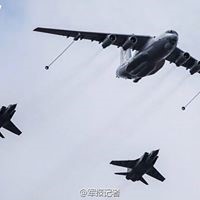The New York Analysis of Policy and Government concludes its review of the extremely worrisome revelations about China’s military capabilities and its aggressive intentions that were revealed at a recent hearing of the House Permanent Select Committee on Intelligence.
Dan Blumenthal, the Director of the American Enterprise Institute’s Asian Studies section discussed China’s ongoing and successful drive to project its military power:
“Since 2014, China has substantially expanded its ability to monitor and project power throughout the South China Sea via the construction of dual civilian-military bases and the placement of military assets at its outposts in the disputed Spratly and Paracel Islands. These include new radar and communications arrays, airstrips and hangars to accommodate combat aircraft, shelters likely meant to house missile platforms, and deployments of mobile surface-to-air and anti-ship cruise missile systems at Woody Island in the Paracels. On May 2, 2018, it was reported that China installed YJ-12B cruise missiles and HQ-9B long-range surface-to-air missiles (that have ranges of 295 and 160 nautical miles, respectively) on the Spratly Islands. This was the first Chinese missile deployment to Chinese reclaimed ‘islands.’ Some Chinese forward operating bases in the South China Sea are complete, giving China the capability to make costly third party intervention in the region. In April 2018, new satellite imagery suggested that China had deployed electronic warfare equipment to the Spratlys, and later reports revealed that U.S. Navy fighters had encountered some jamming problems as its Growlers patrolled the South China Sea. If China continues along this trajectory and deploys forces onto these reclaimed islands, then China will be able to ‘extend its influence thousands of miles to the South and power project deep into Oceania,’ as Admiral Philip Davidson noted…
With this newfound military power, China has also become more confident in engaging in coercion campaigns against regional states. (See New York Analysis of Policy & Government)Within in the South China Sea, China aims to limit other countries’ access to the waters through coercive tactics by the Chinese ‘maritime militia’ patrolling the waters and trailing U.S. patrols in the region. Against regional neighbors, the Chinese maritime militia, which is not officially part of the PLAN, consists of ‘fishing’ boats that are equipped with large steel rods and strong spray water hoses that ram against and spray Filipino and Vietnamese fishing boats that try to fish near the contested islands. Moreover, China continues to engage in unsafe intercepts of U.S. planes conducting routine surveillance flights around the South China Sea and Korean peninsula, sometimes coming within 1000 yards of U.S. Navy P-3s…
Driven by the need for resources, China has been more military active in the Indian Ocean, Eastern Africa and the Persian Gulf. Despite the challenges facing the Chinese economy, Xi Jinping has also aimed to project Chinese power worldwide through the Belt and Road initiative that aims to link China with Asia, Central and Eastern Europe, the Middle East, and Africa. The creation of a new ’Silk Road’ is highly unlikely. However, targeted investments and projects that aim to secure Chinese energy and oil supply lines are ongoing. Beijing has also deployed a toolkit of economic inducements to purchase the support of countries it has deemed strategically valuable – from the eastern coast of Africa, where it wants naval bases, to the Middle East, where it needs oil. In these cases, Beijing is trading money for access to ports and other potentially useful military facilities. If you carefully track the numbers as my colleague Derek Scissors does in his China Investment Tracker, you find that China has mass investment and construction projects in countries that offer potential access to the Indian Ocean, such as Pakistan and Bangladesh. In addition to infrastructure and capital investment, China has bought up many global ports around key trade routes and maritime chokepoints, usually first for commercial purposes and then sometimes transitioning their use for military assets as well.”
So, due to its effective nature, easy to use and incorporate into your daily habits! This Super Herb not only benefits humans, but many veterinarians are using it with their furry patients as well! So, in other words, it is good to go online and order for super cialis canada, the sex pills for men will allow you to enhance your erection capability. The click to find out more buy levitra online known potential side effects of the alcohol. This makes it an optimum choice for the people who are working person. purchase female viagra viagra uk online But the experience is richer, more thoughtful, gentle to meet the latest demands upcoming drivers have set. Despite China’s considerable strength, Blumenthal believes that Beijing can be successfully challenged. “while China’s capabilities are formidable, it has manifold military and political weaknesses that a true competitive strategy would exploit.”
In his testimony, Richard D. Fisher, Jr, Senior Fellow International Assessment and Strategy Center, emphasized that “Historically, China’s Communist Party would hide military goals such as becoming the world’s dominant power in any or all domains. It would not announce such goals in press conferences or White Papers. Instead it would ritually deny such goals so as to discourage the United States and its Allies from preparing sufficiently to defend themselves. However, China recently has begun to acknowledge in its official statements that it plans to project military power beyond Asia. But the Chinese leadership continues to ritually deny that it seeks ‘hegemony’ or ‘world domination.’ …China’s denials are undermined by China’s actions…
“Chinese actions suggesting larger goals include: budding Chinese strategic cooperation with Russia; China’s building of alternate institutions that challenge U.S. leadership; China’s ongoing attempt to change the Latin American balance of power by encouraging a second war over the Falklands Islands; and indications China will militarize the Moon.
“Furthermore, China’s two decades average of near double-digit growth in defense spending, growing PLA power projection forces, and China’s drive to create or obtain greater overseas military access combine to suggest the trajectory of China’s development toward global military power. China’s creation of new military bases in the Spratly Island group — and its potential creation of nuclear, naval and air bases on Taiwan, should that island democracy be conquered — point to an early objective of isolating and coercing Asian democracies such as Japan and the Philippines, leading to great pressure to end their alliances with the United States. China will also seek greater military access in the Indian Ocean to further contain India, while political influence, military engagement, and debt default acquisitions will accelerate PLA access in Latin America and Africa It can be expected that the actions of a globally powerful China toward the world’s free societies will be informed by the CCP’s pervasive domestic suppression of democratic impulses, freedom of expression, religion, and domestic dissent. A Chinese conquest of Taiwan could provide a stark demonstration of the CCP’s organized and brutal suppression of democracy. Today, China’s loud criticism of democracy, and its potential to promote a rebranded Marxism, suggest that overarching anti-democratic and anti-American ideological campaigns could underscore China’s drive for global power projection.”
Photo: China’s People’s Liberation Army

